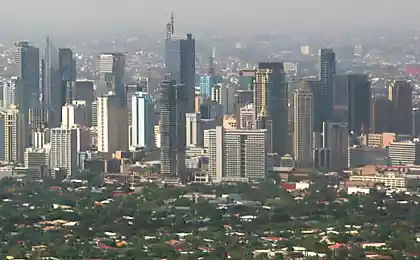1759
Beautiful bird on our planet
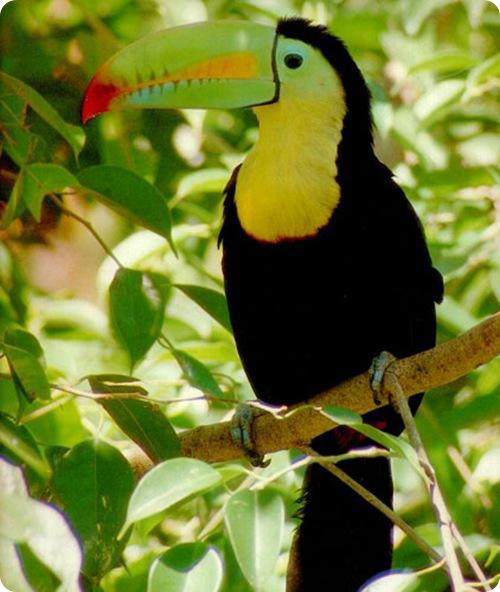
Keel-billed toucan (Ramphastos sulfuratus) is perhaps the most beautiful representative of a group Ramphoslos. Its habitat stretches from southern Mexico to northern Colombia and northeastern Venezuela. This rather large bird, similar in size to the Toco toucan - its body length reaches 50-53 cm, and weight - 400 grams.
Like the rest of the family tukanovyh, keel-billed toucan has a large beak in the shape of a banana, which grows up to 17 cm in length. However, despite the size, the beak is very light, because it is not made of solid bone and a void inside.
Feather on the back, the belly and on top of the wings has a matte black color, and the upper part of the neck is black with a red tint. The chest and cheeks keel-billed toucan painted lemon yellow, podhvoste same bright red. His beak of a bird which got its name, by two-thirds from the bottom of the green with an orange stripe on the side. The remaining third of the beak is red with splashes of blue at the bottom. Variegated coloring allows birds to be masked in the jungle. Males and females are identical for coloring, but slightly larger than males.
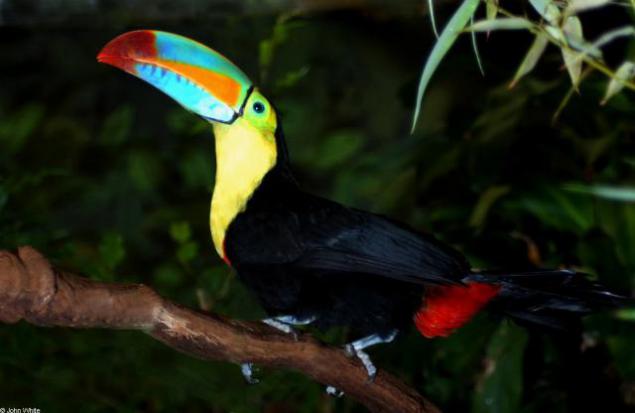
At the keel-billed toucan are short and broad wings, allowing him to maneuver well in the trees. The flight path of a bird like a sine wave: you must first rise up, then the guy down. To make long flights keel-billed toucan could not, in general, prefers to move trees, deftly jumping from branch to branch.
Living keel-billed toucan in small groups of 6-10 individuals. They spend the night in the hollows, and in view of the small size of dwellings, birds have developed a special method of placing them. Birds tightly pressed against each other, and then tuck your bulky beak under a wing of a neighbor that saves space and allows you to fit all individuals.
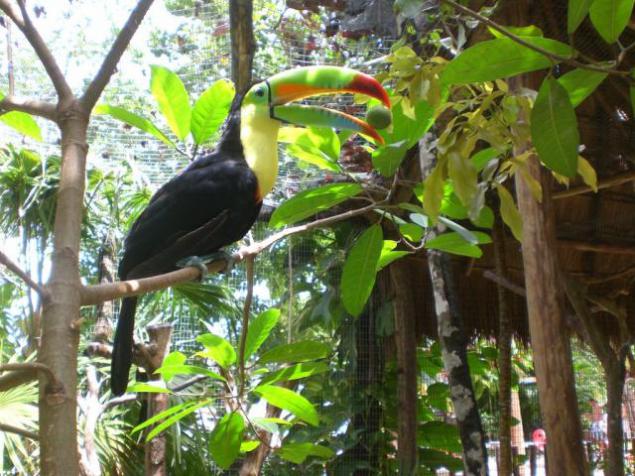
The main component of the diet of birds are fruits, but on occasion she will never refuse to eat insects, tree frogs, eggs, chicks, and even other birds. Most of the food Ramphastos sulfuratus is high in the trees and on the ground down very rarely. Interestingly, fruits and berries are swallowed whole rainbow toucan, so their seeds are not damaged, and go along with the faeces of birds give life to new plants.
Their nests this kind of family tukanovyh suits in natural or other birds carved hollows. It is believed that the keel-billed toucan monogamous. The female lays 2 to 4 white eggs that hatch after 20 days the chicks. During the year, one couple can grow up to three litters. Caring for newborns divided equally between the parents, who take turns incubating, and then for 8-9 weeks, the chicks are fed until they stand on the wing.
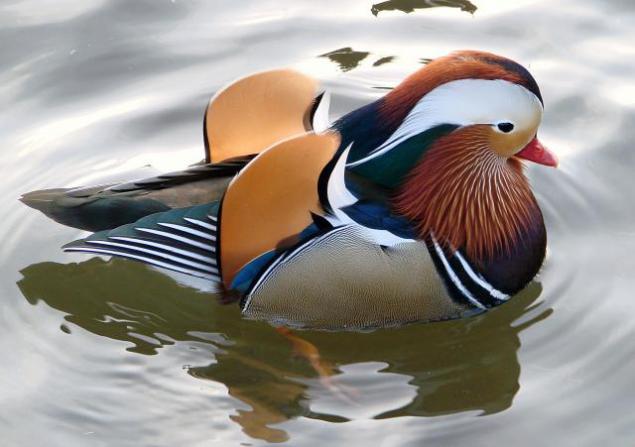
Mandarin duck (Aix galericulata) - a small forest a duck with an incredibly bright color pen, especially duck, so it is often kept in parks and gardens as an ornamental decoration. It owes its name to the bird Chinese officials - tangerines - robes which were very colorful and unusual.
Body length adult mandarin does not exceed 30 cm with a weight of 0, 5 0, 7 kg. The plumage of the drake in breeding plumage combines almost all the colors of the rainbow. The feathers on the head and neck extended, enlarges their volume.
The last flight feathers on both wings are very wide, from the outside painted orange, with thin white edge to edge. When the male Mandarin is not in flight and its wings are folded, these feathers form a high ledge. Goiter bird painted in purple, with a metallic luster, color, abdomen and undertail are white, light brown side with a plurality of transverse pestrinok.

Mandarin female, like many other female duck family has brown color pen: ash-gray head, back, brown, chest, gray mottled with white, belly white.
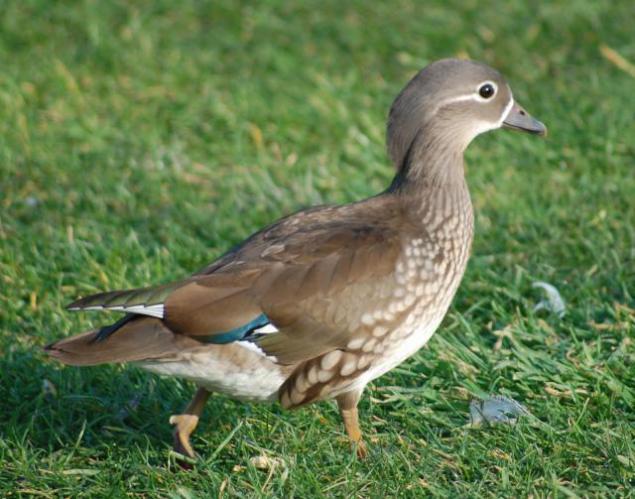
It inhabits this kind only in East Asia, namely the Japanese islands, Taiwan, Primorye, Sakhalin, East China and Korea. In the southern part of the range Mandarin sedentary, from other parts of the winter they fly to Japan, South China and Taiwan.
As the habitat of ducks selected mountain streams with adjacent coniferous-deciduous forests. Swim bird fine, but the dive only as a last resort. Most of mandarin can be found sitting in a tree, which is not typical of other ducks. Actually, their nests and the duck suit in tree hollows, and only in the absence of a suitable hollow, constructed nest on the ground, under cover of dense vegetation and branches.
Females lay an average of 9-10 eggs, which are incubated by her for a month. Male Mandarin all the time is not far away, not flies to moult, as do many other species of ducks drakes. Eaglets, barely Having dried, jump out of the hollow, which is located at a height of 6-10 meters, squared rudiments of wings and webbed paws. These measures, combined with low weight newborns mandarin, allow them to safely survive such a fall.
After that, the whole family goes to the nearest body of water where the chicks will be able to hide in the dense vegetation, and where plenty of food. A mandarin duck eats almost everything: the crustaceans, midges, beetles, small mollusks and small fish and other animals. But this is only half of the diet, the other half are vegetarian food: acorns, rice, buckwheat, seeds and shoots of water plants.

White Pelican (Pelecanus onocrotalus) is the second largest member of the family after the Dalmatian pelican - his weight is 10 kg, length 170 cm wingspan - 3, 5 meters. The name of this species derives from the color of the pen, which becomes pale pink in the third year of life of the bird. In young animals feather grayish-brown with a bluish tinge on the back.
When the pink pelican is on the water, it seems that all his feathers pale pink, but it is not. Bird black flight feathers, but it is visible only in flight. The beak of this species, as well as leathery pouch underneath, painted yellow, pink legs, eyes red.

White pelican breeding range stretches from the Danube Delta in the west to the western Mongolia in the east. Most parts of this species is migratory, although in the most southern areas of habitat have settled population. In the winter the birds fly off in the north-east Africa, as well as in the area between the Persian Gulf and northern India.
For nesting pelicans pink choose ponds densely aquatic vegetation, among which are especially popular deltas. Selyatsya bird colonies whose numbers may reach a thousand individuals.
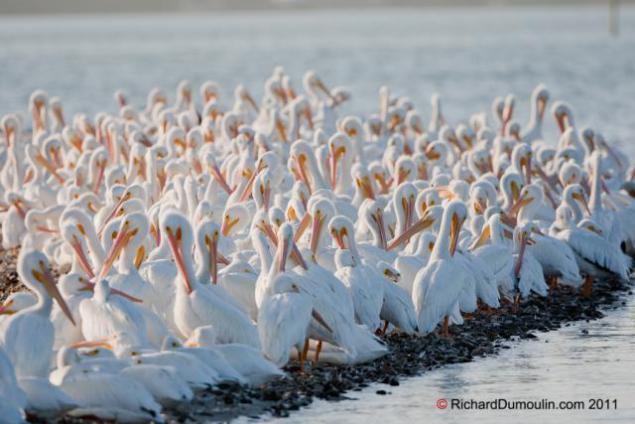
Pairing these birds precede courtship, when they rise into the air, then lowered into water, emit sounds of murmuring and rub their beaks. After this ritual, just a few days the pair is being built a large and untidy construction of dry vegetation and litter, called Nest. Mainly engaged in the construction of females, males also bring building material, often stealing it from its neighbors.
Female pink pelican lays on average 2-3 eggs which she herself most of the time incubates. Male replaces it in the morning and in the evening, when she leaves the nest to feed. After 30 days, the light appears completely naked chicks, their skin is dark, almost black.
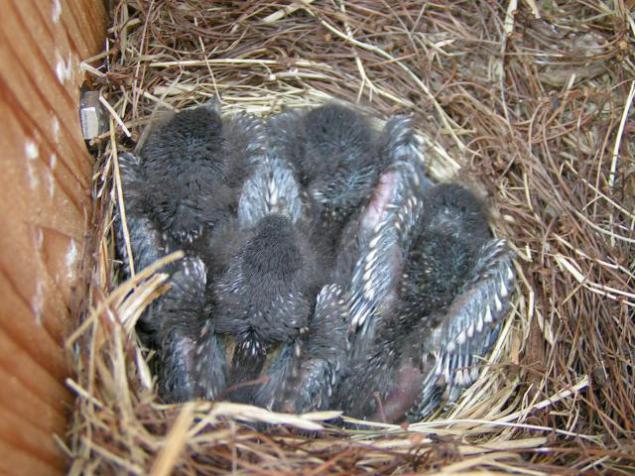
Parents feed their half-digested fish, which belch on the edge of the nest. After a week or two chicks are covered with down, and have eaten directly from the parents' beak, thrusting their heads deep in their mouth. After 3-4 months they are on their own fish and are on the wing, but able to reproduce young individuals will become only the age of 3 - 4 years.
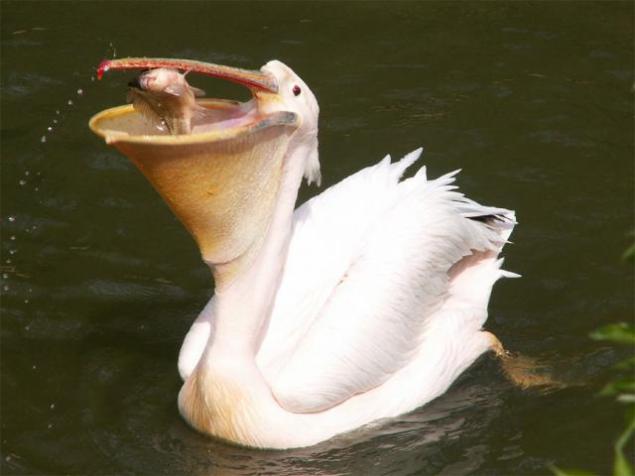
As with all other members of the family, the main food is fish pink pelican. This species has a unique feature - they hunt together, which is not peculiar to birds. To catch fish pelicans stand in a circle, then, flapping its wings on the water, start to narrow it, driving the fish in the center of the ring. When production gets off to a dense flock of birds at the same time start the beaks in the pile, catching fish with their podklyuvnymi bags, turning her head back and swallow. Adult White Pelican day consumes around a kilogram of food.
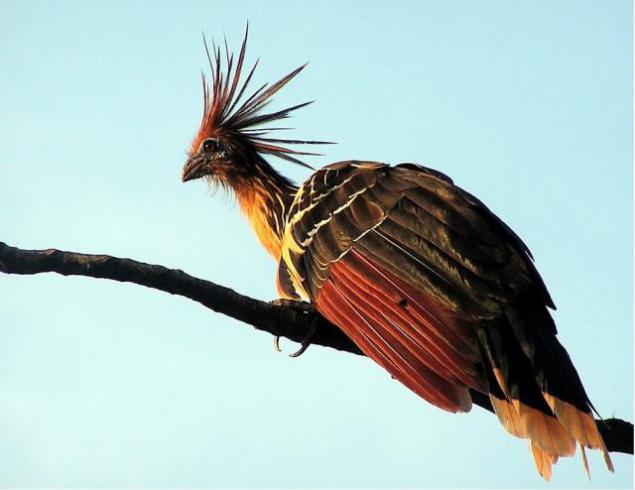
Goatsin (Opisthocomus hoatzin) - a small bird, weighing 700-900 grams, with a small head, long neck and a long tail, at least, the only member of the genus Opisthocomus. In color pen Goatsin dominated by brown tones - back bronze, beige throat and chest, as we move towards the tail belly takes chestnut color. The upper part of the wing brown, tail, too, and the tips of the tail feathers end with a yellow-brown border. On the head, there are several dozen narrow brownish-yellow feathers, forming a mohawk. The short strong beak, black, right behind him on the sides of the head are two patches of skin blue.
Goatsin inhabits tropical rainforests north of the South American continent, in the basins of the Amazon, Orinoco and its tributaries, rising to a height of not more than 500 meters above sea level.
This bird has an anatomical feature that distinguishes it from most of the birds of the world. The fact that the crop Goatsin may be up to 25% of its body weight, which are disproportionately sized goiter other birds. This phenomenon is associated with features of the diet of the species, which is based on the leaves of plants in the family Araceae, as well as small amounts of flowers and fruits. These leaves are dense nutrient-poor and rude, and besides the rubber juice contain toxic substances. Therefore likeness is goiter Goatsin stomach flora which neutralize toxins and starts the digestion of food.
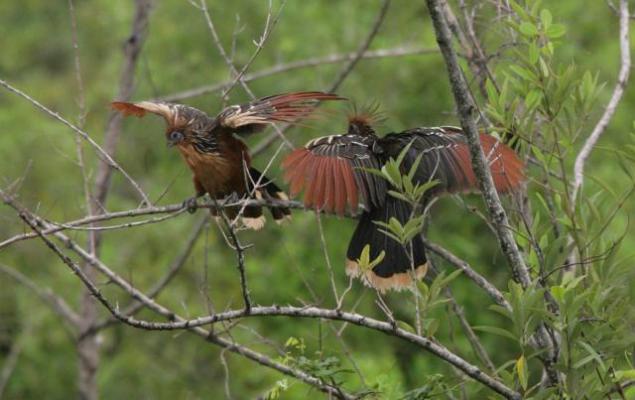
Full digestion leaves portions takes from 24 to 48 hours. The same amount of time food spends in the digestive tract of herbivorous mammals. Because of this feature Goatsin exudes around him extremely unpleasant odor, and its meat is eaten, even the indigenous people of South America. White colonialists and does feathered called it "the stinking bird».
Large goiter take up much space, so the keel bone Goatsin, which is attached to the breast muscles, has a small footprint. As a result, the birds fly very bad, although her wings and large. In fact the flight is pareparhivanii from the upper to the lower branches, and more than 350 meters Goatsin can not fly.
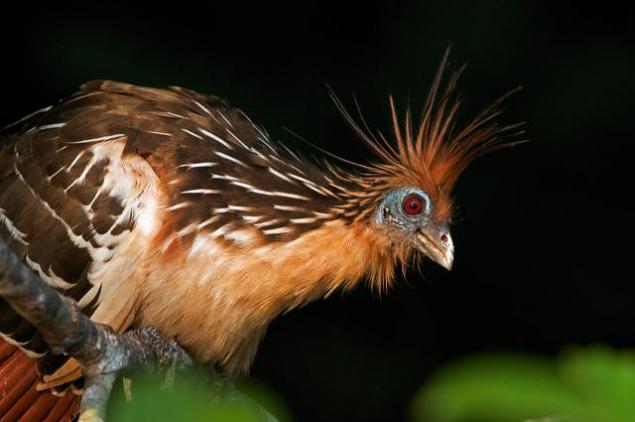
These birds live in large flocks numbering up to hundreds of individuals, and only in the mating season break into smaller groups of 3-8 birds, often consisting of a pair with last year's brood. Immatures help educate young adults and to protect the territory of the group is usually not more than 160 square meters. meters. The breeding season lasts from December to July. Nest is located in the bushes near the water, and is a platform of twigs piled in a heap. The female lays an average of 3 white, with brownish-red spots, eggs that incubates for 30 days.
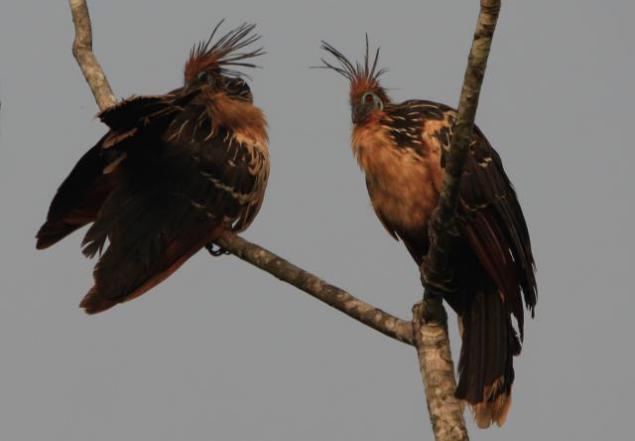
Young Goatsin born helpless and almost naked, the parents feed them belch out half-digested vegetation, but because of its low nutritional chicks grow slowly. In young animals have an interesting feature: the second joint of their wings has two claws, making them look like prehistoric Archaeopteryx. Chicks goatsintov swim well, in fact, in the case of danger, they deliberately fall into the water, and then with the help of four pairs of limbs again climb trees.
A flock of feeding young animals up to 2 months, and claws on the wings are reset at 2, 5-3 months. By this time they were already eating alone.
Goatsin active in the morning and evening hours, rest of the time relaxing, sunbathing. Their main enemies are the ocelot, opossum and tsebus, and among pernatyh- black buzzard, the falcon and the sparrow hawk. In nature, these birds live more than 10 years (more about them, see the video below).
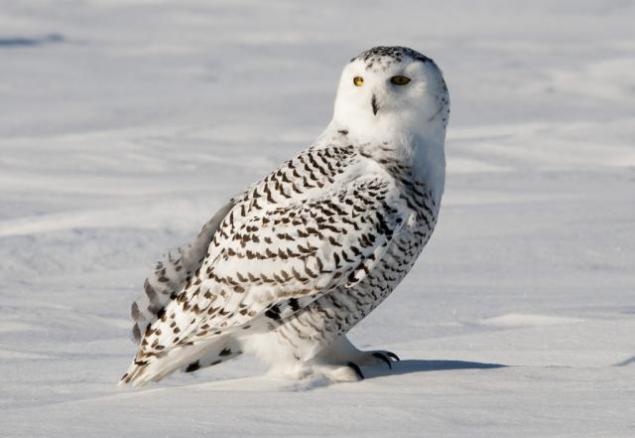
POLAR or snowy owl (Nyctea scandiaca) - typical predator northern latitudes. It is common in the tundra, in North America and Russia, as well as in Siberia. Probably before this species and in Scandinavia, as evidenced by the Latin name of the bird. Woodlands tries to avoid, preferring the lodges in open spaces or spurs of the mountain hills at over 1000 meters above sea level is not flies.
White Owl is the largest predator of the polar line. Females in size and weight are superior males.
The wingspan of the adult reaches one and a half meters, the weight of large females - up to 2 kg. See predator snow is not easy, as the color of the pen adult birds is almost completely white, visible only small and rare black streaks. In females streaks usually larger and older males are completely white, without taking into account a few black stripes on the tail.
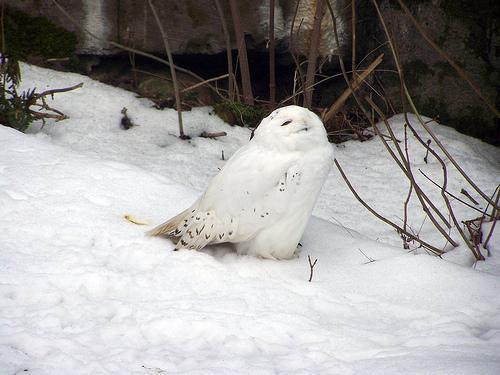
In view of the existence in conditions of extreme cold, snowy owl plumage is very thick and warm, legs covered with a thin pen resembling wool, or even the beak is almost completely hidden under a small feathers.
During the summer, snowy owl eats mainly rodents (most lemmings), to a lesser extent in fish and game birds. In winter, when food is less hunting rodents and rabbits, cutting to the birds, and will not give up on the fell. To catch prey uses several methods of hunting. Sometimes the bird chooses a place higher up, sits down, and looks for prey.
Snowy owl's head can be rotated 270 degrees, so that from its vigilant eyes can not hide. However, most predator hedge-hopping scouring the tundra, and the sight of prey catches and grabs her. In the case if the victim is larger than the hunter, like a hare, the glaring claws owl will hang on him as long as he does not cease to resist, and then finish off a powerful beak. Small prey eaten by a predator entirely on the spot, the larger torn apart claws.
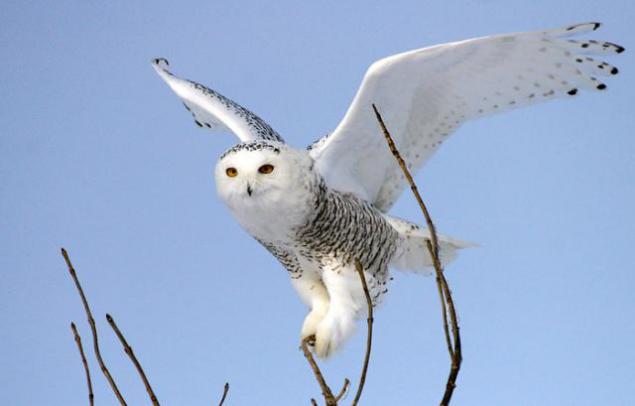
The courtship season at polar owls is in March-April. Courting the female, the male brings her food, flying, flapping their wings and ruffled follows her on the ground. In late May, the female starts laying, and the day is delayed no more than one egg. Their total amount depends on the amount of food. In the year of famine Snowy Owls may not nest, but if enough food in the masonry can be up to 14 eggs.
The nest is arranged directly on the bare ground where the female digs a small depression claws, sometimes snowy owl takes the nests of other large birds. Incubation lasts just over a month, and after removing a few chicks begin to leave the nest to search for food. After about two months of youngsters getting on the wing.
It is worth noting that next to his nest polar owls do not attack the birds, but the threat of aggressive actions of their offspring. This is used Geese, ducks and waders, forming a whole colony of nests around the predator, and live under their protection.

Zelenokryly or red-green macaws
Ara chloropterus
Parrots; body length 78-90 cm, tail 31-47 cm; Weight 950-1700 g has a beautiful, bright color. The basic color is dark-red, blue-green wings. Cheeks not feathered white bare face is decorated with small red feathers, arranged in several rows. Nadhvoste tail and blue. Nadklyuvya straw color with a black tip, and sulfur-mandible black.
It lives in Panama, Colombia, Venezuela, Brazil, Argentina and some other South American countries.
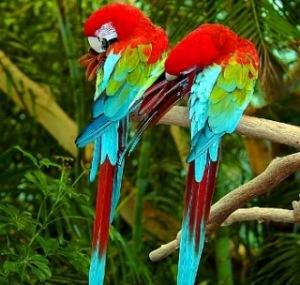
Boled inhabit tropical forests, both in the plains and in the mountain areas. Hold the bird usually in pairs. They are cautious, they are difficult to observe in the trees. Good fly, a top speed of 60 km / h. Has excellent vision and hearing. Good climb trees. Are active in the daytime, and in the hottest hours of rest in the trees.
They feed on plant foods, mainly palm nuts. Daily flying on river mud flats where the red clay lick. Until now, the exact cause of this behavior is not established. It is believed that thereby poultry neutralize toxins contained in unripe fruits. Sometimes cause significant damage to corn plantations.

They nest in hollows of old trees, and often is adjusted to the required size of the hollow with the help of his beak. The female in this litter is not hollow. In laying usually 2-3 eggs. Incubation lasts 29 days.
Pretty quiet birds, often they are kept at home, where they feel good. Can memorize and say certain words and whole phrases. The life expectancy of 30-50 years.
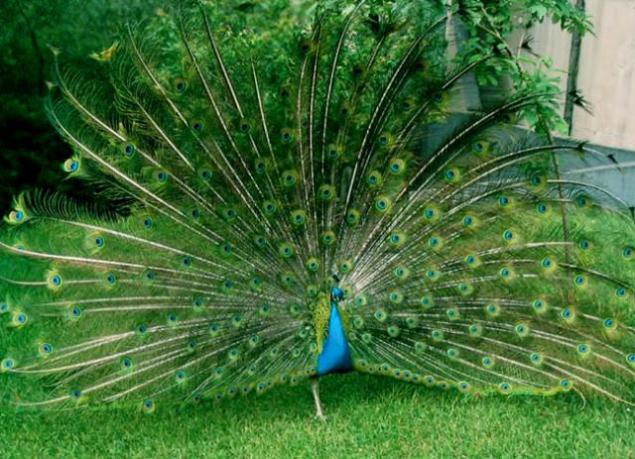
Peacock or Indian Peafowl (Pavo cristatus Linnaeus 1758) - the most abundant species of peacocks. Is a monotypic species, that is not divided into subspecies, however, it has a number of color variations (mutations).
Sources:







